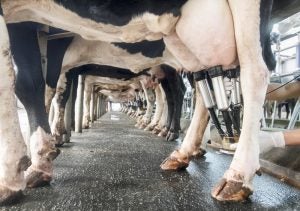The Food and Drug Administration confirmed on Tuesday that pasteurization of milk consistent with the federal Grade “A” Pasteurized Milk Ordinance destroys harmful pathogenic bacteria and other microorganisms, including Highly Pathogenic Avian Influenza and other viruses.
HPAI is a highly contagious disease and often deadly in poultry, caused by highly pathogenic avian influenza A (H5) and A (H7) viruses; it is also known as bird or avian flu.
Wild birds can transmit HPAI viruses to domestic poultry and other bird and animal species. Although bird flu viruses do not normally infect humans, sporadic human infections have occurred. It is important to note that “highly pathogenic” refers to severe impact in birds, not necessarily in humans.
»Related: USDA confirms avian flu is spreading cow-to-cow
HPAI and milk system safety
The U.S. Department of Agriculture, FDA, and the Centers for Disease Control and Prevention, along with state partners, continue to investigate an outbreak of highly pathogenic avian influenza virus impacting dairy cows in multiple states.
Infection with the virus is causing decreased lactation, low appetite, and other symptoms in affected cattle.
The FDA and USDA have indicated that based on the information currently available, the commercial milk supply in the U.S. is safe because of these two reasons: the pasteurization process and the diversion or destruction of milk from sick cows.
The pasteurization process has served public health well for more than 100 years. Pasteurization is a process that kills harmful bacteria and viruses by heating milk to a specific temperature for a set period of time to make milk safer.
Even if a virus is detected in raw milk, pasteurization is generally expected to eliminate pathogens to a level that does not pose a risk to consumer health. However, pasteurization is different than complete sterilization; sterilization extends shelf life but is not required to ensure milk safety. While milk is pasteurized, not sterilized, this process has helped ensure the health of the American public for more than 100 years by inactivating infectious agents.
Nearly all (99 percent) of the commercial milk supply produced on dairy farms in the U.S. comes from farms that participate in the Grade “A” milk program and follow the Pasteurized Milk Ordinance, which includes controls that help ensure the safety of dairy products. Pasteurization and diversion or destruction of milk from sick cows are two important measures in the federal state milk safety system.
As noted by USDA, some press reports from the World Health Organization, and other sources state that the virus has been detected in raw milk. Based on available information, pasteurization is likely to inactivate the virus; however, the process is not expected to remove the presence of viral particles. Therefore, some of the samples collected have indicated the presence of HPAI using quantitative polymerase chain reaction (qPCR) testing.
During the course of the outbreak, the FDA has been evaluating milk from affected animals in the processing system and on the shelves. The FDA is completing a large representative national sample, to understand the extent of these findings better. Because qPCR findings do not represent actual viruses that may be a risk to consumers, the FDA is further assessing any positive findings through egg inoculation tests, a gold standard for determining viable viruses.
“To date, we have seen nothing that would change our assessment that the commercial milk supply is safe,” wrote the FDA in a statement. “Results from multiple studies will be made available in the next few days to weeks.”

Precautions for raw milk
The FDA has a long-standing recommendation to consumers not to consume raw milk (milk that has not been pasteurized). Because of the limited information available about the possible transmission of the H5N1 virus via raw milk, the FDA continues to recommend that the industry does not manufacture or sell raw milk or raw milk products, including raw milk cheese, made with milk from cows showing symptoms of illness, including those infected with avian influenza viruses or exposed to those infected with avian influenza viruses.
Importantly, the FDA has also recommended producers take precautions when discarding milk from affected cows so that the discarded milk does not become a source of further spread. Producers should consult with their state regulatory authorities for specific recommendations or requirements; however, such precautions should include heat treatment, pasteurization or its equivalent, of discarded milk prior to dumping in lagoons or application of waste solids and ensuring biosecurity around lagoons (e.g., ensuring that animals and birds do not have access to lagoons). Any raw milk or raw milk products from exposed cattle that are fed to calves (or to other animals, such as farm cats) should be heat-treated or pasteurized.
»Related: Food Science Babe: Risks and benefits associated with raw milk


